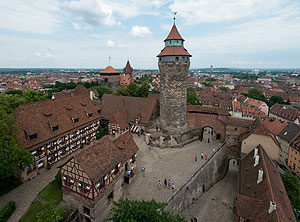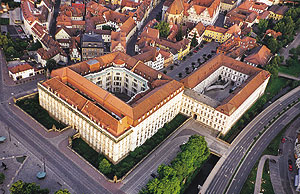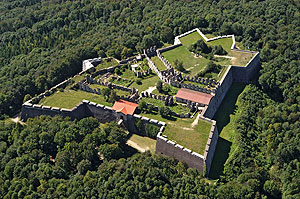Main information:
Information on your visit
Further sights
Further properties administered by the Bavarian Palace Administration in the surrounding area are the Imperial Castle Nuremberg, Ansbach Residence and Court Garden as well as the Rothenberg Fortress Ruins:
Imperial Castle Nuremberg and castle gardens
In the Middle Ages, the Nuremberg castle was one of the most important imperial castles of the Holy Roman Empire. The huge complex was built by the Hohenstaufens and their successors over the remains of previous buildings from the time of the Salians.
The double Imperial Chapel is one of the oldest remaining parts of the castle complex (c. 1200). Some of the imperial residential and state rooms in the Palas have late medieval and Renaissance panelling.
The permanent exhibition »Emperor – Empire – City. The Imperial Castle in Nuremberg« shows not only clear explanations of the elements and function of the castle, but also presents information about the Holy Roman Empire of the German Nation and the role of Nuremberg in the late Middle Ages in a vivid and exciting form that will appeal to visitors of all ages.
In addition to the main castle gardens, the Imperial Castle also has the so-called Maria Sibylla Merian Garden, which is named after the important Nuremberg artist and naturalist.
Ansbach Residence and Court Garden
Ansbach Residence evolved from a medieval complex. Its Gotische Halle (Gothic Hall), a feature of the original building, today houses the important collection »Ansbach faience Adolf Bayer«. The Residence was rebuilt in its present form by Gabriel di Gabrieli and Karl Friedrich von Zocha in the 18th century. The early Rococo interior was created by Leopold Retti.
Further highlights are the fresco on the Banqueting Hall ceiling by Carlo Carlone, the Art Gallery with Rococo paintings and works from the former Margrave's Gallery (Branch of the Bavarian State Galleries) and the collection of Meißen porcelain in the Mirror Cabinet.
Opposite Ansbach Residence in the court carden with its orangery there is also a rose and medicinal herb garden.
Rothenberg Fortress Ruins – Schnaittach
A medieval castle originally stood on the site of the baroque fortress: a Hilpold von Rothenberg was mentioned for the first time in 1254. Rothenberg was later owned by the burgraves of Nuremberg, followed by Emperor Karl IV, who as King of Bohemia thus acquired a new outpost. In 1401 King Ruprecht took the castle from King Wenceslas in Bohemia.
During the Thirty Years' War, the castle was occupied by Bavarian troops, posing a considerable threat to the free Protestant city of Nuremberg. In the Spanish War of Succession, the now heavily fortified castle was taken in 1703 by the imperial troops and completely destroyed. After the peace treaty of 1714, Elector Max Emanuel rebuilt it as an even more powerful fortress, which proved its worth in the Austrian War of Succession when it withstood an attack by the Austrian army. After the Napoleonic Wars the fortress declined in importance, and in 1841 was abandoned and fell into ruin.
In 1966 the ruined fortress passed to the Bavarian Palace Administration, which is now taking steps to prevent its further decline; the Schnaittach bastion is being made accessible as a viewing platform and a large part of the massive casemates will be opened up for guided tours.




Recommendation in the social media
Facebook Twitter Google Plus